Sorbus aria 'Lutescens' & Rufus The Orange Cat
Saturday, May 02, 2009
 On Thursday I took Hilary to the SPCA to look for a cat that would replace her Raúl who has gone missing for two weeks. Raúl is 15 years old and he was not well. After seeing a cat she liked (he was an orange cat called Rufus) she said she would wait and have Bruce and the girls see it. Alas this was not to be as when we returned with the girls today Rufus was being put in a carrying box to be taken home. There was one wonderful moment on Thursday. I took Hilary to Kaplan’s and we had a Montreal smoked meat sandwich which we enjoyed with a black cherry soda. On our way to her house I passed by Montgomery, between 42nd Street and 41st and I had to stop the car. There were trees on that block that I had never seen. They had rugose silver white leaves. One of the trees had been recently planted. It had a tag! The tag read Sorbus aria ‘Lutescens’. A sorbus is commonly called a Mountain Ash which is a member of the very large rose family. While it is called a mountain ash it is not an ash as an ash is from a different genus, Fraxinus. I could not figure why this variety was called 'Lutescens' as that means yellowish, and I could not see yellow anywhere. I went home and did some investigation with my tree books. This tree is called a whitebeam and the mysterious yellow is to be found in the down of the silvery young leaves. There is a hint of that in the upper view of the scan seen below left. The long row of whitebeams on Montgomery was dazzling. They were ghosts that cheered me up. I will have to return to see what the summer white flowers look like. Like many mountain ashes the whitebeam will have clusters of red berries in the fall. 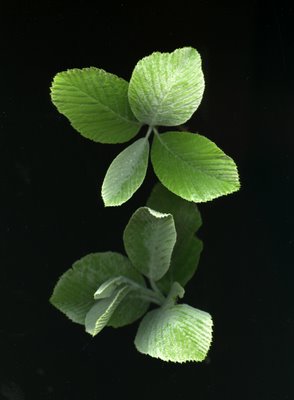 When Rebecca found out that Rufus had been taken she cried. I could not console her. It seems that she has grown up just a bit with the experience while Lauren seem to show no emotion. Perhaps at age 6 she was not aware how quickly Rufus won our hearts and how fate then broke them. Addendum: I became curious on the closeness between sorbus and sorbitol. The connection is logical. Here it is: Sorbitol, a sugar substitute also occurs naturally in many stone fruits and berries from trees of the genus sorbus.
A Carriage Person
Friday, May 01, 2009
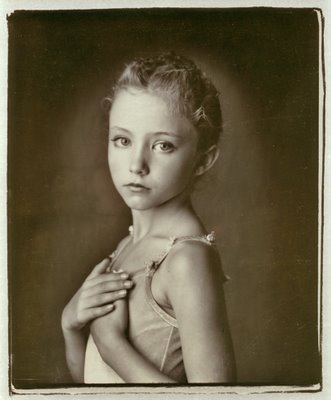 Miss Lydia Louisa Summerhouse Donkins informs Mrs. Cameron that she wishes to sit for her for her photograph. Miss Lydia Louisa Summerhouse Donkins is a carriage person, and therefore, could assure Mrs. Cameron that she would arrive with dress uncrumpled. Should Miss Lydia Louisa Summerhouse Donkins be satisfied with her picture, Miss Lydia Louisa Summerhouse Donkins has a friend who is also a Carriage person who would also wish to have her likeness taken. Miss Lydia Louisa Summerhouse Donkins informs Mrs. Cameron that she wishes to sit for her for her photograph. Miss Lydia Louisa Summerhouse Donkins is a carriage person, and therefore, could assure Mrs. Cameron that she would arrive with dress uncrumpled. Should Miss Lydia Louisa Summerhouse Donkins be satisfied with her picture, Miss Lydia Louisa Summerhouse Donkins has a friend who is also a Carriage person who would also wish to have her likeness taken.I answered Miss Lydia Summerhouse Donkins that Mrs. Cameron, not being a professional photographer, regrets she was not able to ‘take her likeness’ but had Mrs. Cameron been able to do so she would have very much preferred having her dress crumpled. Julia Margaret Cameron
Annals Of My Glass House
Thursday, April 30, 2009
 I turned my coal-house into my dark room, and a glaze fowl-house I had given to my children became my glass house! The hens were liberated, I hope and believe not eaten. The profit of my boys upon new laid eggs was stopped, and all hands and hearts sympathized in my new labour, since the society of hens and chickens was soon changed for that of poets, prophets, painters and lovely maidens, who all in turn have immortalized the humble little farm erection. Having succeeded with one farmer, I next tried two children; my son, Harding, being on his Oxford vacation, helped me in the difficulty of focusing. I was half-way through a beautiful picture when a splutter of laughter from one of the children lost me that picture, and less ambitious now, I took one child alone, appealing to her feelings and telling her of the waste of my poor Mrs. Cameron’s chemicals and strength if she moved. The appeal had its effect, and I now produced a picture which I called ‘My First Success”. I was in a transport of delight. I ran all over the house to search for gifts for the child. I felt as if she entirely had made the picture. I printed, toned, fixed and framed it, and presented it to her father that same day: size 11 by 9 inches. January 1865, Annals of My Glass House, Julia Margeret Cameron
You Only Live Twice - In Veracruz
Wednesday, April 29, 2009
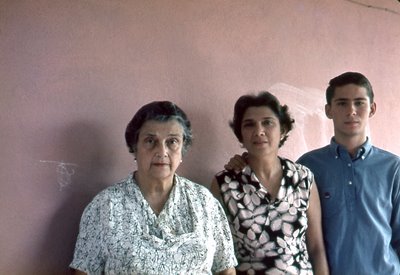 Some of the happiest moments of my life happened in Veracruz. I first saw the sea as an adult there. After having lived for some years in Mexico City’s high altitude I had forgotten that sound travels through the air. My mother quit her job as a teacher at the American School in Mexico City in 1963, because of health reasons. She had a terrible case of Meniere’s disease with a constant ringing in her ears, a horrible almost constant nausea and the rapid deterioration of her hearing. Doctors told her that living at sea level might soften her symptoms. So she applied to work for a small American School in Veracruz where she would teach the children of the American workers of Alcoa.  After my first night sometime in 1963 I woke up to sound. Every sound seemed to be precise, clear and loud. It took me while to grasp that at sea level, sound really traveled not like in Mexico City’s thin air at 2224 meters. For breakfast, my mother’s cook and helper prepared the most fabulous cheese omelet I had ever had. This was after my mother had said, “Favor, Petra, prepare un desayuno para el joven.” Please Petra prepare breakfast for the young man.” 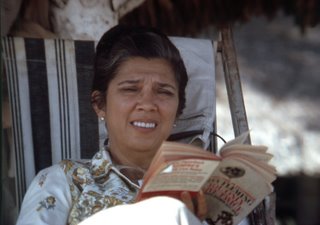 In 1967 I traveled with my soon to be bride, Rosemary. I told my mother jokingly that I would need some 3 in 1 oil to oil the hinges of the bedrooms. That first morning I heard my mother say, “Favor, Petra, prepare un desayuno para el señor.” Rosemary was still asleep and suddenly I had graduated from being a young man to a man! I remember that Rosemary spent most of the day taking showers. A native of New Dublin, Ontario she had yet to be accustomed to the humid heat of Veracruz. It was in Veracruz where Rosemary and I went for walks on the malecón (a Spanish word for a seaside boulevard) and had tall cafés con leche at the Café de la Parroquia in the centre square of Mexico’s oldest city. We would watch the noisy trams go by and noisy but still pleasant marimbas would play on the street. For a few pesos you could request them to invent lyrics on the spot. They would sing to the merits and beauty of my blonde Rosemary. I smoked cigars and pipes at the time so I would go to the tobacconist on the Hotel Diligencias and pick some long thin Flor de la Costas. This was life at its best. We were young and it seemed that we could dream a world even if we had little money. We liked to sit on the zócalo (main square plaza) on Sundays. The young men would stroll in a clockwise direction (I am not too sure of that) and the young women in the opposite direction. On Easter Sunday these youths would throw at each other eggs that were full of confetti. It was in 1963 when I first went to Veracruz that I first met three of my mother’s friends. One of them was German and she had a big clunky Toyota jeep like vehicle. She owned a store in town that sold Mexican curios. The other two were delightful American women (one of them looked like actor Strother Martin) who loved to read Ian Fleming and play bridge. I learned to play bridge from them as well as being handed down every Ian Fleming, James Bond novel as soon as it became a pocket book. I never bothered to notice that there was something odd. It was only in retrospect and many years later that I found out that my mother had befriended a coven of lesbians! There were some protests from the parents of the children she taught but somehow my mother stuck to her friends. My grandmother lived with my mother for a while in Veracruz. Then she went to visit her son Tony in Egypt. When she came back she did not recognize us. In this picture my grandmother seems to be in that second stage. I must have taken it around 1965 when I returned on leave from my military service in Buenos Aires. It was around then when Ian Fleming’s You Only Live Twice appeared as a paper back. I remember my mother trying to read it in the glare of the sand of Mocambo Beach. My mother’s house, which was also the school was on Martín Alonzo Pinzón. He and his two brothers had sailed with Christopher Columbus. Pinzón had been the captain of the caravel, La Pinta. For those who believe that Columbus discovered America there are now rumblings from those wanting to name Pinzón (who was an excellent mariner) as the co-discoverer. 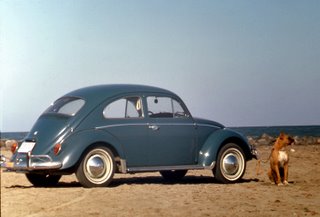 It was in Veracruz that I first learned to drive. My mother had purchased a brand new blue VW Beetle. She also had a very large boxer called Antonio whose tongue was so long that part of it was always sticking out. Rosemary and I would take the car and Antonio and walk him on the beach. When Rosemary and I got married, a few months after my mother most generously helped us buy our very own VW. To this day I remember with warmth and excitement those Friday night trips where Rosemary and I would drive, after our last English classes of the day from Mexico City to Veracruz. The trip took us from those 2224 meters to a sudden downhill to sea level by the time we crossed into the Veracruz State border near Córdoba. We would open the windows and we could smell that wonderful humid air that smelled of wet earth with a hint of the nearby sea. We could hear the insects and see the fireflies. Arriving very tired sometime around one in the morning to the welcome of my mother and Antonio’s barking was paradise.  Paradise it was until one night when Rosemary went to the bathroom and I heard her scream. It seemed that the bathroom had been invaded by flying cockroaches. She soon learned to share our paradise.
The Plastic Hippos Of Disneyland
Tuesday, April 28, 2009
 This is my first cousin David Humphrey. I took this Ektachrome in Mexico City while he was having his siesta sometime in 1961. He may have been 5. He was a likeable kid and I remember taking him for a walk in Chapultepec Park and the Mexico City zoo. It was there where David, unwittingly, taught me a lesson on the perception of reality. I proudly showed David the hippos which were basking in the sun, semi-submerged in an artificial lake. David told me, matter a factly, “ These hippos are boring. The ones in Disneyland make more noise and move more. They are not so lazy.” I pointed out to David that the Disneyland hippos were made of plastic and had internal motors that made them move. I told him that the hippos we were looking at were the real thing. David stuck to his guns and I was not able to dissuade him. After 1961 I never saw David again. From his brother Robin I have learned he is doing just fine, he is married and is a gemologist. That evening when David and I got home I made a firm commitment that I would never go to Disneyland. In 1975 when Ale, Hilary, Rosemary and I drove to settle in Vancouver we stopped by Disneyland. I delivered my wife and daughters to the Disneyland entrance and I then maneuvered my way through the LA freeway to a big photography equipment store where I bought all the stuff I had been unable to buy in Mexico City. I had been teaching in Mexico City and when Rosemary suggested we move to Vancouver I had made the decision to start from scratch as a photographer. Around 1980 we sent our daughters to visit friends in Mexico City. On the way back they met up with Rosemary in Los Angeles who was there on business. “My boss had left me a Cadillac so I took the girls to Disneyland.” On September 11, 2001 early in the morning Hilary, her husband Bruce, Rebecca and Lauren were ready to go to the airport. There were going to Disneyland. Bruce turned on the TV to check the weather. They never went to the airport and both Rebecca and Lauren have yet to go to Disneyland. I wonder, are they are missing anything?
Two Rauls - One An Orange Cat
Monday, April 27, 2009
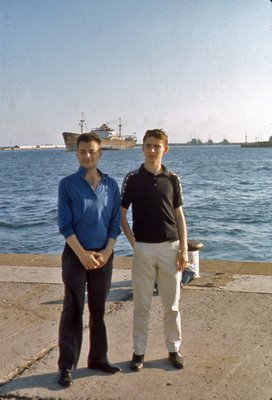
Two Raúls and a bit of a third have been on my mind these last few days.
When my youngest daughter Hilary was born in 1972 her godfather was Raúl Guerrero Montemayor. I first met him around 1963 at an uncle’s house. Raúl was born, I believe since he likes to waffle on this one, in the US. His father was Filipino and his mother Mexican. Raúl’s first cousin is actress Yvette Mimieux. Raúl looks so much like first Filipino president, Manuel M. Quézon that there have been persistent rumours that he is Quézon’s illegitimate son.
I met Manuel Quezon’s son, Nonong in 1967 shortly before I married Rosemary. I was staying with Raúl. My mother lived in Veracruz so while I was looking for a job in Mexico City Raul lent me his loft as a temporary living quarters. Nonong came to visit him from the Philippines and I noted that Raúl looked a lot more like the ex-president’s son than the real son did. Nonong soon gave me a nickname, Suput. It is a nickname that has stuck with those who really know me. In the Muslim parts of the Philippines like Mindanao, I would be shunned for being an unclean heathen.
I need not go into further details except to note that when I go to Goldilocks, the Filipino bakery on Fir and Broadway to buy “polvorones” or Filipino shortbread I am instructed to wite my name on a little sheet of paper to place my order. The Filipino women behind the counter then yell out the names. I have yet to hear them even whisper mine. They now know me and they simply say, “Andong, what do you want?” and I circumvent the little paper bureaucracy.
It was around 1964 that Raúl invited me to accompany him on a trip from Mexico City to Veracruz. I had not seen the sea since I was 7 and I had gone with my mother and grandmother to Mar del Plata in Argentina. I was attracted to the idea of a little pilgrimage to the sea. There were countless curves, steep hills and down hills. I remember Raúl constantly downshifting as he maneuvered around the curves in his VW Beetle. I remember our first look of the water and the pungent smell of salt, bunker oil and the sewer of the port of Veracruz. Only now I would assert that it was that smell that has become a memory that seems to be the primordial soup of my existence. I lay to bed my trip to Mar del Plata. Here was a new standard. We swam in Mocambo Beach and I lightly scraped my face with the ocean’s sand (really the Gulf of Mexico) and felt clean. Raúl told me of the curative properties of coconut water. We had lots of it. We got the runs.
Raúl is now in his 80s and he still travels so he can practice the over 10 languages he speaks. He was delighted when I told him that Hilary had named her orange cat Raúl after him some 15 years ago. I could not tell him that it was a half truth as Hilary had also named him after actor Raúl Julia whom she admired.
Raúl, the orange cat has been missing for almost two weeks. Hilary cries. Rebbeca cries. Lauren is much too young to understand. This could be the first death that hits home for Hilary. When this happens it is when we really begin to suspect that our journey is a short one and that the 15 long years of a cat’s existence seemed to have passed ever so quickly.
John Cruickshank & The Persistence Of Print
Sunday, April 26, 2009
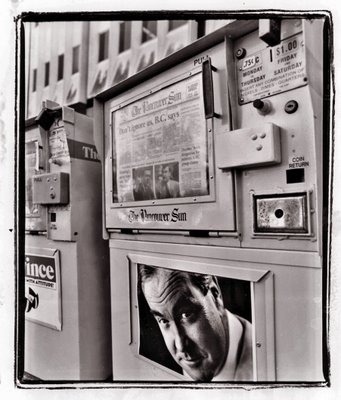 In my ever increasing photography classes (those who can’t, teach) I have been telling my students that until just about now, photography gave me access. In a world where even one of my neighbours, two doors down, drives a brand spanking new Bentley, access is the only real show of one’s perceived importance. It certainly is not wealth. One of my fondest moments in my photographic career happened about 5 years ago when I went into the Vancouver Sun news room to talk to my friend Nick Rebalski. Rebalski and I had an “unwritten” method of operation. I would submit him an article which he would then edit and pass it on to his boss, David Beers who was the editor of a new and exciting cultural section of the Vancouver Sun called Saturday Mix. I had a pretty good batting average, 1000 % in baseball terms. Many of my articles appeared on the front of Mix and with a big picture. As I was about to leave I was stopped by John Cruikshank (in photo, left) who was the Editor-in-Chief. He put his hand on my shoulder and told me, “Alex accompany me to my office.” We walked the length of the news room. Staff writes just stared. Inside his office, Cruickshank told me that my contributions to Mix were welcome and appreciated and that soon I would have an opportunity to contribute more as he had decided to get David Beers to “Mix” the rest of the paper. Within days I was invited to lunch by a few Sun writers but Cruickshank’s plans were not to be. David Radler sent him to the Chicago Sun Times. Beers, without his mentor, was left hanging with no mandate. Beers finally left the Sun under circumstances that were all not that pleasant and Mix deteriorated and then disappeared. And my personal contributions to the paper did that, too. I remembered Cruickshank (he is now publisher of the Toronto Star) yesterday as he figures prominently in an interesting article in Saturday’s Vancouver Sun written by David Akin. There have been many articles in both print and web media on the endangered species the hard copy newspaper has become. Vancouver Sun’s fine columnist Stephen Hume has already written a couple on the subject and will write a third this coming Thursday. In fact Saturday’s full page article is the first of five more that will finish on Friday. Cruickshank the optimist states, “There certainly will be newspapers in two years, five years, and 10 years time. They may be somewhat different [but] we’re a long way from disappearing as either news companies or as print operations.” Coincidentally, it was Maureen Dowd in today's New York Times who found a far more logical reason to report for the persistence of newspapers. Dowd’s column deals with a tour she was recently given by Phil Bronstein editor-at-large of the money losing (a million a week) San Francisco Chronicle. Dowd writes: His tour ended with cold comfort, as he observed that longer life expectancies may keep us on life support. “For people who still love print, who like to hold it, feel it, rustle it, tear stuff out, do their I.F. Stone thing, it’s important to remember that people are living longer,” he said. “That’s the most hopeful thing you can say about print journalism, that people are living longer.” For my part I would like to add a few more to that startling prediction. Numerous New Yorker cartoons have appeared through the years of Mr. Smith reading his paper at the breakfast table while ignoring his poor suffering wife, a lowly domestic before women’s lib. When women’s lib happened the cartoon became one of selfish alienation and as both sat down at the breakfast table but read different sections of the paper or perhaps he the Wall Street Journal and she USA Today.A New Yorker cartoon that would show Mr. and Mrs. Smith reading the day’s news on line on side by side computer monitors seems most unlikely. The method could be as it is at an American friend's house, after dinner. He is married. She smokes, he doesn’t. She is upstairs in the bedroom with her computer, a martini and a cigarette. He is in the basement (as far from second-hand smoke) with his computer, a coffee or a beer. My point is that reading a hard copy newspaper is a social event, a pleasant social event, that happens in three-dimensional space and not facing the two dimensions of computer monitor. In my house it happens in bed. Now that Rosemary no longer works we wake up later at 7:15. I go downstairs to make breakfast (coffee for her, tea for me, hot cereal with brown sugar for her, two unbuttered scissor rolls for me, orange juice for her, V8 for me). I feed our cats and then when they go out into the garden I pick up both our Vancouver Sun and the New York Times. I bring the papers and our breakfast up in a wicker tray. We make sure we find the daily comics in the Sun and then we each read each paper in no particular order. We discuss the news and we tell each other of interesting columns or articles. After all this we get out of bed to face the day. Reading those papers in bed, our head propped up by pillows is an experience, a shared experience, that will never be supplanted by "his" and "her" laptops, at least not for the next five years if we are to believe John Cruickshank.
|


















